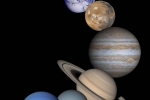In November - transit of Mercury across the disk of the Sun with visibility in the European part of Russia. Then the planet will achieve the greatest elongation in the morning sky.
Venus sparkles low near the southwestern horizon at dawn.
Mars is visible against the background of the morning dawn in the constellation Virgo.
Jupiter and Saturn shine in the evening sky low near the southwestern horizon in the constellations Sagittarius and Ophiuchus.
Uranus is visible throughout the night in the constellation Aries, being close to its confrontation.
The distant giant Neptune is observed in the first half of the night in the constellation Aquarius.
The sun moves through the constellation Libra, November 22, passing into the constellation Scorpio.
The moon will approach the indicated planets: on November 2 in the evening with an increasing phase of 0.31 - with Saturn,
November 7 evening with an increasing phase of 0.78 - with Neptune,
November 11 at night with an increasing phase of 0.99 - with Uranus,
November 24 morning with a decreasing phase of 0.07 - with Mars,
November 25 morning with a decreasing phase of 0.02 - with Mercury,
November 28 evening with an increasing phase of 0.04 - with Jupiter and Venus,
November 29 evening with an increasing phase of 0.1 - with Saturn.
For observations, it is better to choose nights when the Moon near the full phases does not pass near the observed planet.
Circumstances of visibility are given for the middle latitudes of Russia (about 56 ° N). For cities north and south, celestial bodies will be located at the indicated time, respectively, slightly lower or higher (by the difference in latitudes) relative to their places in the sky of Bratsk. To clarify the local conditions of planet visibility - use planetarium programs.
MERCURY moves backward along the constellation Libra, November 21, moving to a direct movement. The planet is not visible for the first half of the month, hiding in the rays of the daylight, November 11, Mercury will pass along the disk of the Sun - residents of Europe, North and South America and Africa will be able to see this rare event.
Mercury becomes available for observation in the evening sky from the middle of the month. On November 28, Mercury will reach the greatest elongation of 20 °, but its visibility is unfavorable in the middle and high latitudes due to the low declination in the sky - the planet is low above the horizon.
The angular size of Mercury in the sky decreases after joining from 9 "to 6", and the brightness of the planet increases from 11m to -0.6m. The phase of Mercury changes from 0 to 0.66 - with a telescope you can see how the sickle of the planet increases to a half-disk. At the beginning of the month, the elongation of the planet is 19 °, decreasing to a minimum towards conjunction with the Sun. Then the elongation will increase to 20 ° by the end of the period under review.
It is recommended to build an individual horoscope in the astrological program STAR WAY
In November - transit of Mercury across the disk of the Sun with visibility in the European part of Russia.
2019.11.06.






